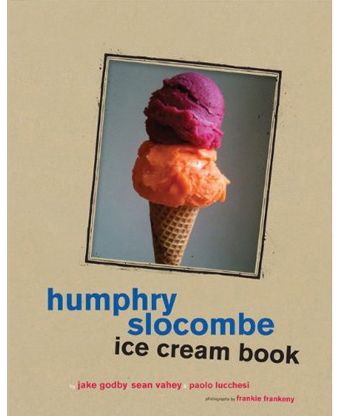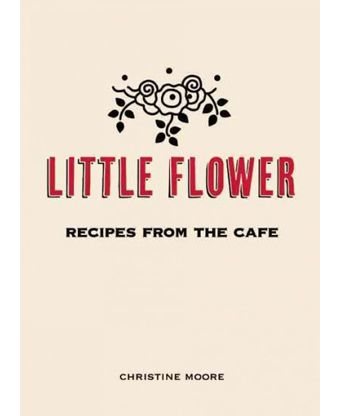Reading the introductions to the Humphry Slocombe Ice Cream Book and the Little Flower cookbook is an exercise in opposites.
An excerpt from each:
Little Flower:
The café was born in 2007. That was a really tough year… At 44, I found myself with a premature baby, a broken marriage, a 5-year-old, a 7-year-old who had just been diagnosed with Tourette Syndrome, a husband out of work, a cancelled health insurance, and no way to pay the mortgage.
Humphry Slocombe:
Hey, bitches, thanks for buying our ice cream book. We worked really hard on this thing (over many drinks) and hope you have as much fun making ice cream from these recipes as we have since opening the shop in San Francisco. We can’t promise you your money back, and in fact have probably already spent it on pills and liquor, but if you don’t like the ice cream, we will eat a bug.
My first thought was that given what Little Flower author Christine Moore already went through to both open her successful café and manage to find the time to write a cookbook, her book just had to win by force of will alone. Besides, if Humphry Slocombe owners Jake Godby and Sean Vahey, and their co-author Paolo Lucchesi lost, they’d just eat a few bugs and get over it.
My directive from the Piglet folks was to “cook dinner from each book.”
For Little Flower, this was easy. My menu went like this: Ham Tart, green salad with Carrot Ginger Dressing, Roasted Cauliflower & Leek Soup, and Pear & Quince Crumble. Plus, because I have a sweet tooth the size of a whole body, I also planned to make Perfect White Cake (would it really be perfect?), and something called Foley Cake which had jam and almonds in the photo. And while I was at it, being the brown butter fanatic that I am, I added Brown Butter Shortbread and Ginger Molasses Cookies (also made with brown butter) to the list.
Planning a dinner menu from Humphry Slocombe was more challenging, but fun.
I figured I’d start with Strawberry Olive ice cream as an aperitif, make my way to Boccalone Prosciutto and Government Cheese for some protein, try the Hibiscus Beet sorbet for some vegetable matter, Elvis (The Fat Years), with banana and peanut brittle for some fruit, and finish with Here’s Your Damn Chocolate Ice Cream for dessert. Then I’d wash everything down with something called Jesus Juice sorbet made with red wine and cola...just because...I mean, how could you not?
Then I started cooking. First, I concentrated on Little Flower. And as I tested them, I got the feeling that the recipes, which probably work wonderfully in the kitchen of Little Flower, were not tested in a home kitchen.
The Pear & Quince Crumble took 60 minutes in my conventional oven instead of the 30 called for. And even so, while the flavor of the filling was superb, the crumble topping was still very soft and a bit too mushy in parts.
The Perfect White Cake, which was perfect, taste-wise, also took an hour instead of half an hour (though it was worth the wait). But a testing problem here: the recipe makes two large, fat round cakes, but the glaze recipe, studded with lavender flowers, only made enough to cover one of them.
The Foley Cake, with almonds and jam, was fabulous, moist -- a wonderful recipe, except that it needed an extra 25 minutes of baking. Still a keeper with a margin note.
Next up, the gorgeous-looking ham and cheese tart. This required me to make quick puff pastry. I was tempted to substitute purchased puff pastry, but wanting to be faithful to the recipe, I didn’t. So I made the quick puff pastry, which wasn’t at all quick. The recipe made a lot of dough, too much dough for my standard home mixer, which meant I had to do the whole thing by hand.
Growing frustrated and wishing I’d just bought the dough, I assembled the tart. I felt better as the whole kitchen became engulfed in the scent of butter and pork. The recipe said the tart would take 30 minutes. My stomach started growling at 25. At 30 minutes the tart was pale and soggy. At 45 it was less pale and still soggy. After an hour it was dark brown on top, but the puff pastry still wasn’t baked through. I ended up peeling off the topping to eat, and tossing that hard-wrought crust.
At this point I began to wonder if the chef (or recipe tester) used a convection oven for testing the recipes. Since I had enough puff pastry for another tart, I made the whole thing again and baked it on my convection setting. This time the recipe worked and the pastry cooked through (it still took 50 minutes instead of 30). It was tasty enough at the end, but not spectacular.
Other issues: the Brown Butter Shortbread was greasy. And while the Ginger Molasses Cookies had a crisp texture and nice spicy flavor, there was so much clove in the recipe that the use of brown butter was moot. Also, the directions for that recipe were problematic. They called for rolling out the balls of dough, placing them on 2 baking sheets and freezing them on the sheets before baking. But it was impossible to fit one let alone two baking trays into my freezer. I chilled the dough in the fridge and rolled out balls of cold dough, which seemed to work nicely.
There were more little things like that throughout the book, tiny little testing and editing errors. A skilled cook could work around them, but they would flummox a novice.
Interestingly, the recipes that worked the best were not baked goods. The Carrot Ginger Dressing was balanced and zippy and lightly sweet, a delightful foil to arugula. And the Roasted Cauliflower and Leek Soup was both easy to make and satisfying.
Full disclosure, before testing Humphry Slocombe, I google-stalked the place and ended up on Amazon. The reviews of the cookbook were not good. There were many complaints that the recipes had too much salt and sugar.
While not every recipe I made was something I’d make again (particularly the Hibiscus Beet and the Jesus Juice sorbets, which were icky), I loved the ice creams. Maybe they were too salty and too sugary for some people, but I adored them. Plus, the ice cream textures were lusciously smooth and not at all icy. (This might be because of the large amount of sugar used, which can help prevent ice crystals from forming.)
The first ice cream I whipped up was based on Elvis (The Fat Years). I didn’t have the time to confect the peanut brittle so ended up making the banana base and studding it with crunched up pretzel and chocolate chunks. The banana custard base was the star -- it was creamy, dense, and tasted like banana bread but cold and sticky (in a good way).
The Here’s Your Damn Chocolate Ice Cream was apparently only created in the shop to placate the bevy of screaming children who demanded it, and it’s a very kid-friendly ice cream (read: super sweet). It starts with a caramel base to which cocoa and good chocolate are mixed in. The caramel adds flavor and also keeps the texture nice and scoopable even after it’s been sitting in my home freezer for days. Some of my friends thought this ice cream was over-the-top cloying. I agree that it’s not a sophisticated, dark, bitter flavor; it’s more like a melted, frozen Milky Way bar. Serve it for your ten-year-old’s birthday party.
More fancy dinner-party appropriate are the Boccalone Prosciutto and Government Cheese (made with Mimolette) ice creams. These, as expected, walk the line between savory and sweet. Either would make a thrilling topping for apple pie or apple crisp.
I had my doubts about the Strawberry Olive ice cream. Before the olives are added to the strawberry ice cream base, they are candied until they resemble salty raisins. The whole thing was complex and interesting enough to make each bite a little different, which kept me eating out of the container long after I should have closed the freezer door and walked away.
Given the ups and downs of each book, deciding upon a winner was tough. The Little Flower book was problematic, but considering the strength of at least four great recipes (Perfect White Cake, Foley Cake, Carrot Ginger Dressing and Roasted Cauliflower and Leek Soup), it could have won.
But in the end, the unmitigated joy of the ice creams coupled with the absolutely hilarious prose made Humphry Slocombe prevail.
So there you have it. Irreverent and crave-able ice cream wins over earnest but inconsistently-tested baked goods.
And I’m keeping both books. Next time I make that Perfect White Cake, I’ll serve it a la mode, with a scoop of Strawberry Olive.



29 Comments
What are you really implying?
I read few, if any comments from anyone that "conveyed offense" - odd phrasing - to Ms. Clark's review. Several of us did comment that we had in fact had better results with the recipes and/or participated in testing them at home. This led to some thoughtful comments about the rigors of prepping a cookbook for publication, what to expect when attempting a recipe for the first time, and more. All useful points of view that I would expect would be welcome in a forum of passionate cooks, professional or otherwise.
On a personal note. Those of us who were fortunate enough to watch Little Flower Recipes from the Cafe come to life - understand what went into creating this cookbook. We watched Christian pour her heart and soul into the book (like all or most authors do) - because she allowed us to all be part of the process. To us, imperfections and all, Little Flower Recipes from the Cafe is simply perfect and already a winner.
And should you be in the Pasadena area - stop by what many of us call home away home - Little Flower Cafe. It's a family of foodies and non foodies, artists and strangers walking in off the street. Sometimes you'll be sitting at a table with friends or family and Christian will come out of the kitchen with some new adventurous dish for us to sample and critic. Then you might understand better why we are so passionate about the cafe, the book and the incredible woman behind both.
I believe that one must always consider his/her audience when writing recipes or instructions. If I were writing a chocolate chip cookie recipe, for example, for a restaurant kitchen, I might just say "cream method @ 375F," and a skilled baker would know precisely how to execute that recipe instruction. A home cook, especially a novice cook, however, would likely be lost. I found myself reading Little Flower's recipes only to find numerous places where instructions could have, and should have, been much clearer. The lack of detailed instructions simply left too much room for error, which is costly and frustrating for the home cook. Another pet peeve I noticed, and noticed more than once, were recipes that called for "chopped chives," yet the photo clearly showed chopped thyme. That's when I lost all faith that this book had been edited carefully, if at all. From the comments, home cooks did test recipes, which is important; but, it is also critical to enlist professional recipe testers and editors to properly assess the accuracy of recipes and instructions, and I am not convinced that happened here. (For a an eye-opening view of the two-year+ process it takes to develop a successful first cookbook, see Joanne Chang's "Flour "Bakery" blog posts that discuss her adapting bakery recipes for a home kitchens, addressing fluctuations in measurements and oven temps, and recruiting 'home testers.')
I love Little Flower's backstory, and based on rave reviews of her food, I am sure Moore is a marvelous cook; however, cooking and recipe writing/editing are two very different, distinct skill sets. After decades of cooking, writing, editing, and eating good (and bad) food, I have training and experience that allow me to read a recipe, and without entering the kitchen, determine how it will taste, if a step is missing or inaccurate, if a seasoning is off, etcetera. A home cook, however, might not have enough experience to make that determination, or to prevent mistakes. Unless a cookbook is specifically marketed to a professional cook, I believe it should be instructive enough to ensure that even the most novice cook succeeds, can execute a recipe flawlessly, and ideally, learn something new to make her a better cook. Because these attributes were lacking in Little Flower, I must agree with Melissa's verdict.
Tough round- both books are a little 'rough around the edges.' I appreciate Melissa's thoughtful review.
Sent from my iPad
In my experience, tweaking and adjusting is the norm when following any recipe for the first time. Everything - from which method you use to measure your flour, if the liquid ingredients are room temperature or straight from the refrigerator, how fresh your dry ingredients are - it all has an impact. To me, it's that bit of uncertainty, and the need to be totally present during the cooking process, that makes cooking so expressive and enjoyable.
I highly recommend Christine's book - and if you're in the LA area, a visit to her amazing neighborhood bakery/cafe, where you can have a great meal and pick up a copy.